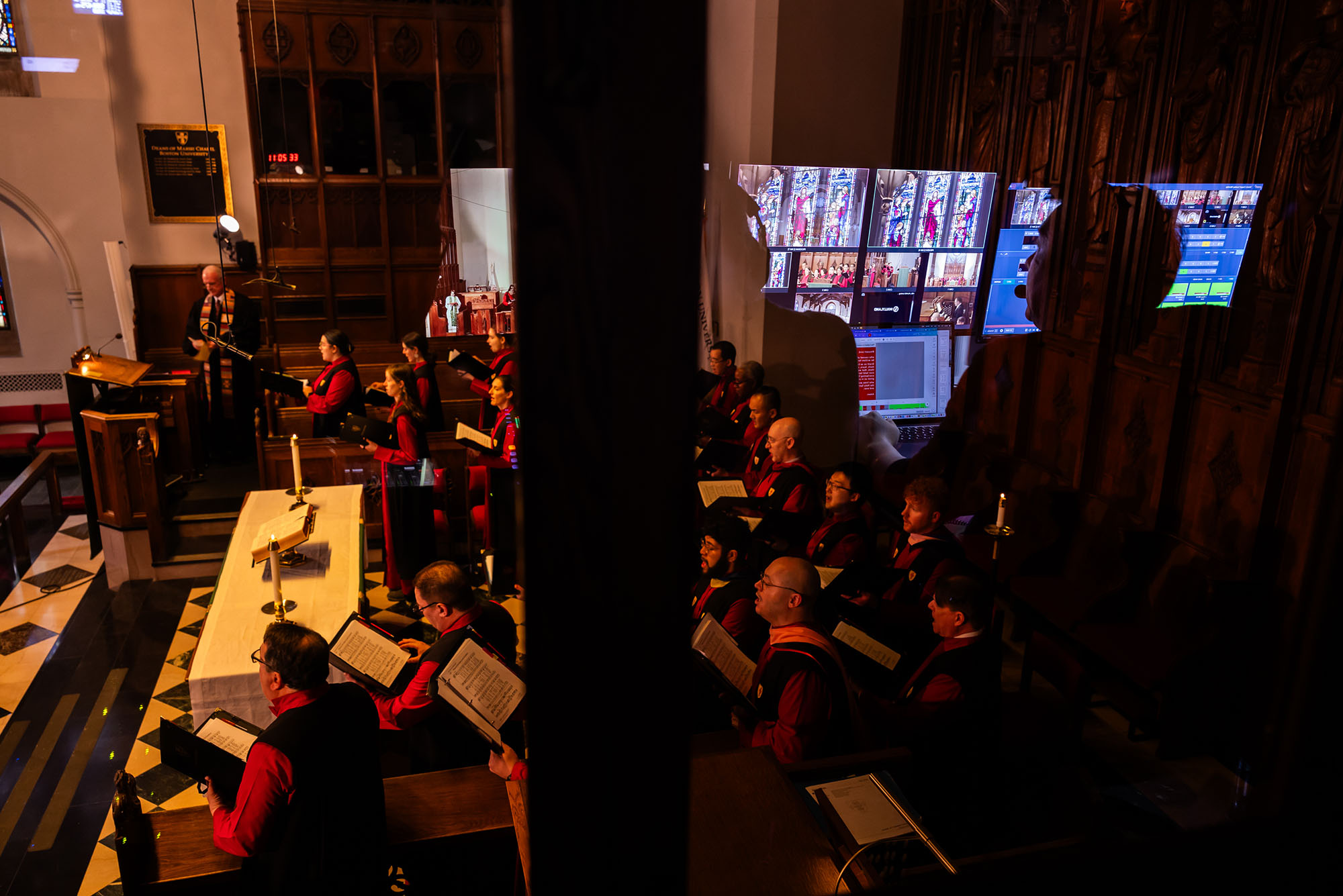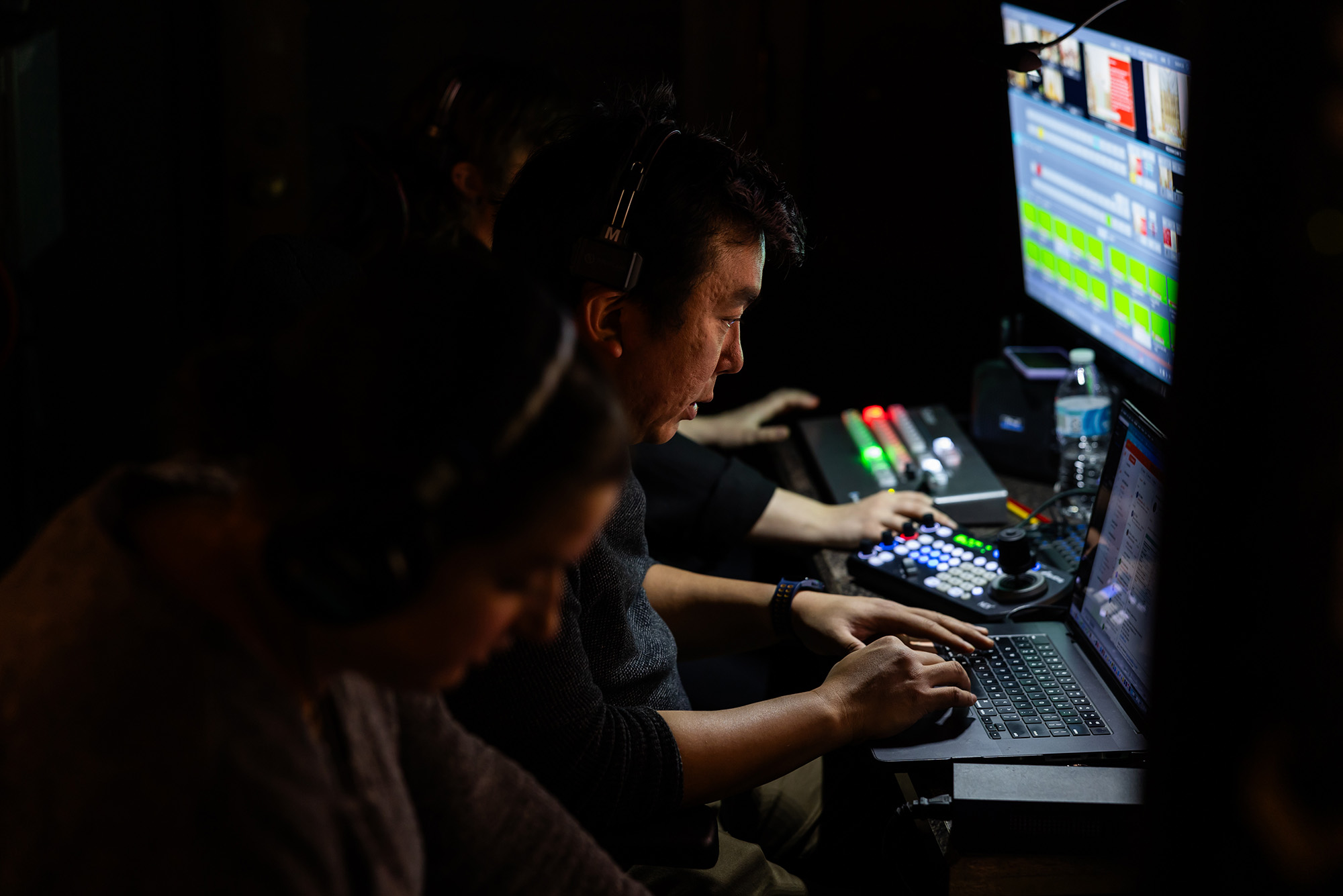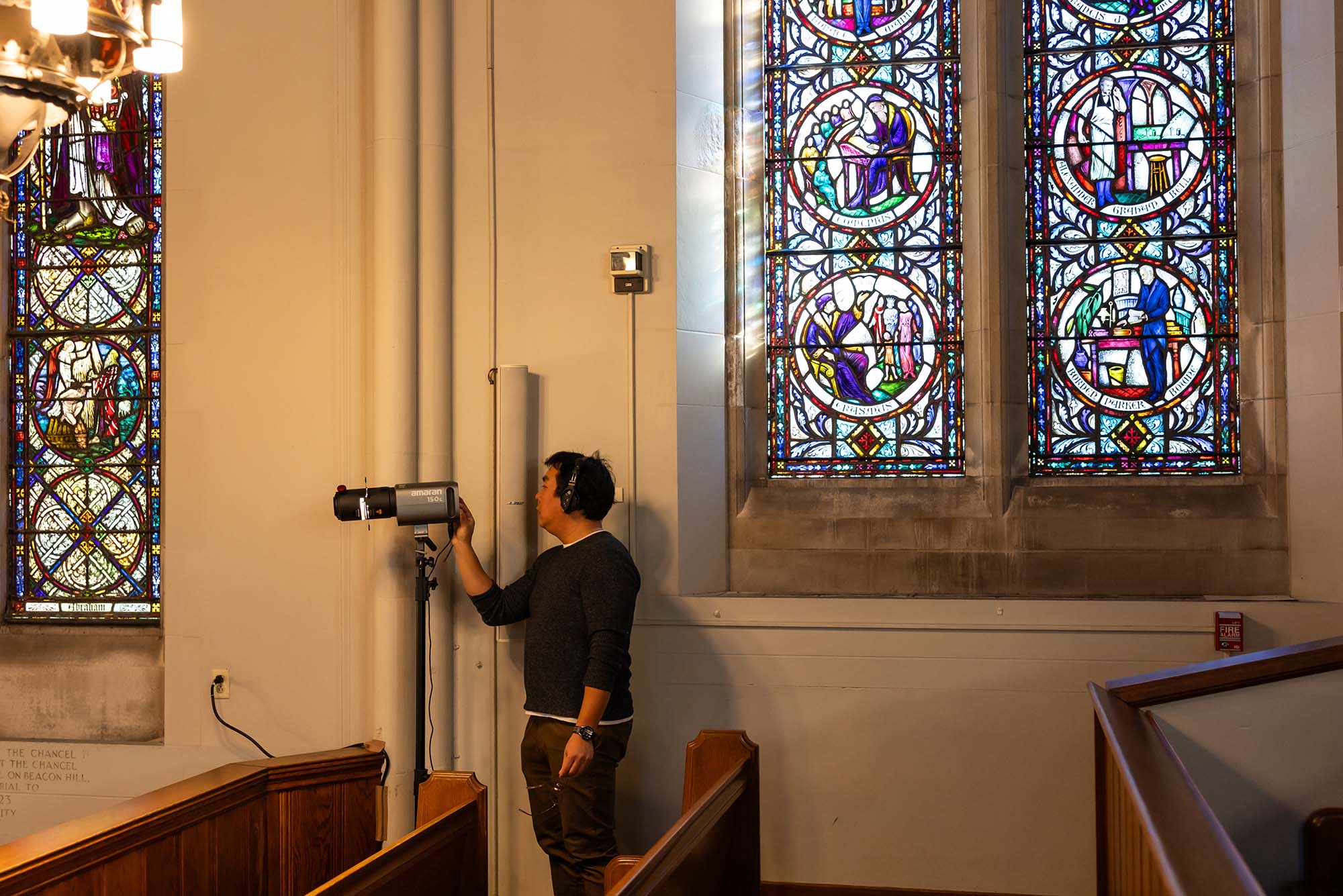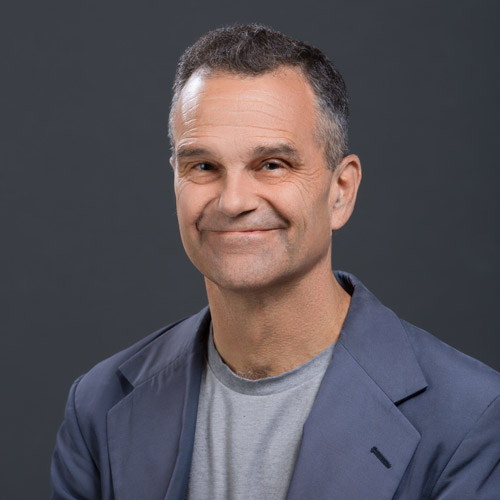A Tech Maestro Helps Bring Marsh Chapel into the 21st Century

As Marsh Chapel services unfold below the sound booth, Sung Jin Choi, Marsh Chapel’s technical director of media, keeps track of what online viewers see via a monitor capturing multiple camera angles.
A Tech Maestro Helps Bring Marsh Chapel into the 21st Century
Sung Jin Choi oversees livestream of chapel’s weekly services and online presence
There’s scant light inside Marsh Chapel’s ribbon-thin sound booth. Outside in the chapel proper, there’s too much.
“The color temperature messed up,” says Sung Jin Choi, Marsh’s technical director of media, staring at a monitor with multiple cutaways of a recent Sunday service. Sunlight streaming through the chapel’s stained glass has bleached the livestream that’s being watched—and will be later, when it’s archived—by hundreds of congregants.
Choi and two assistants, flanking him and staring at their own monitors, adjust the camera aperture to normalize the color before switching to another camera for a different view. Jin commands five stationary cameras placed throughout the chapel, each PTZ (pan, tilt, zoom)-capable, while a third assistant roams the service with a handheld camera to capture additional angles.
The sound booth hangs perhaps a dozen feet above the altar’s organ. It once serviced WBUR, the University’s NPR station, which aired Marsh’s Sunday worship for 70 years, until May 2023. Wiring from those radio days snakes along the floor. “We have all these wires running that are kind of mysterious,” Choi says. “We don’t really know where they go to.” Former BU President Robert A. Brown authorized installation of the cameras to begin livestreaming that May as well. Choi, who took up his part-time role the following November, has professionalized the operation.
Watching him at work during worship conjures Steven Spielberg (Hon.’09) directing an epic. He calls out cameras by number as he guides his assistants during starts and finishes to different sections of the service: ”Ready one, take one. All right, Introit. Ready 4, take 4.” At one point, he tells his roving camerawoman, “Beauty shot, please,” and his screen shows her camera panning up a chapel wall to focus on a stained-glass window and a chandelier. “You can still slowly pan now,” Choi instructs her. “Keep panning. Good job.”

“We’ve been stuck in the mid-20th century,” Scott Allen Jarrett (CFA’99,’08), Marsh’s music, arts, and cultural engagement director, tells BU Today. Now, the chapel is “embracing this moment with livestream and the hiring of somebody with Jin’s capability and strength, skill, and expertise to help us grow into the 21st century and [take advantage of] the full suite of digital communications options that are available.
“Jin’s job as technical director is not just to amplify the music of Marsh Chapel—it’s to amplify the full voice of the chapel.”
In addition to directing the Sunday livestream, Choi creates and posts a podcast of each Sunday service on the chapel’s website that draws about 150 weekly listeners. He also initiated and oversees the chapel’s YouTube channel.
“Jin is a wonderful, excellent addition to our senior staff,” says the Rev. Robert Allan Hill, dean of Marsh Chapel. Choi’s expertise is being brought to bear as Marsh prepares to celebrate its 75th anniversary later this year. On the cusp of that milestone, Jarrett says, he had contemplated “how we can best present the chapel, our very beautiful history [and] the prominence of this building. There’s not a building that’s more central than this one—I can’t think of another campus in the United States, secular or not, that has a chapel at the center of campus.”
Marsh’s and Jin’s efforts make a local snapshot of an ancient story: religion adapting to new communications technology. “I used to say that the printing press, the Protestant Reformation, the Gutenberg Bible, all of that, is the most important event of the past millennium,” Jarrett says. “I think the internet, the digital age, the access to information that we have now, is probably a similar avalanche, a waterfall of new information that our society will have to process over many generations.”
Or as Choi puts it, “Tradition meeting technology.”
Guiding religious communication into the 21st century
Choi’s appointment in November 2023 followed Brown’s initiating a process (which will require “successive fiscal-year asks,” Jarrett says) to purchase cameras and upgrade the chapel’s audio and lighting systems. What made Choi an enticing hire, Jarrett says, was his experience as a tech whiz, which grew out of his (by his own description) not-good-enough-to-support-himself talents as a saxophonist. He loved the instrument after taking it up as an undergraduate at SUNY Fredonia. But stacked against others who’d been “playing from, like, five years old…it was really hard to catch up,” Choi says. Instead, he majored in sound recording technology—“how to record, how to get better sound compression.”
Choi’s postgraduate employment included three years at ESPN, working with engineers on audio and video quality. “My hours there were pretty harsh. I started at 6 pm, and then I was done at 5 am.” He married a Boston woman, and they split weekends between Beantown and Connecticut until she became pregnant. A month before she was due, Berklee College of Music recruited Choi as a video assistant. The job not only united the family under one roof, but for eight years, he cut his teeth on tech skills as he coordinated the school’s concerts and recitals.
“Berklee really made me think about the music [working] with the video…oh, we need to switch it on this shot, fading into this shot. The experience with Berklee, being exposed to a lot of music, really helped me out a lot,” he says.

“There’s a certain beauty, definitely a beauty about imagining what’s going on while you’re listening to it. But I think visually helping [with livestreams] almost makes you feel like you’re there, even though you’re not.”
Marsh’s new tech-ventures required ironing out a few bugs, with Choi adjusting the podcast to fix its “muddy” sound. Livestreaming, meanwhile, began with baby steps. ”I think they used Skype at one point,” he says.
When the chapel switched to video cameras, the automatic setting left the white balance (the color balance that makes images look cool or hot) constantly changing. Also, the cameras were static. “I like to move cameras,” Choi says. “The camera movements actually tell us a lot of stories. So I started the moving cameras,” adjusting them remotely through their PTZ functionalities. He also fine-tuned the white balance. In the future, he hopes to add podcasts, perhaps of musical performances and talks by Hill. One example of future storytelling that he’s pondering is a podcast that talks with couples who got married at Marsh.
“I want it to be more personal,” he says. “I want to tell some stories.” Choi’s efforts are more than just tweaks in pursuit of technical flawlessness. To him, streaming the service is “kind of like a storytelling. I started showing the stained glass, beautiful stained glass in Marsh Chapel, and showing the whole chapel itself. We try not to show as many people as possible.”
The son of Presbyterian parents, Choi says his wife and their two children attend Grace Chapel in Lexington, where he also works as part-time technologist. He doesn’t worry about making church himself: with his Marsh job, he says, “I actually work on Sunday.”

Comments & Discussion
Boston University moderates comments to facilitate an informed, substantive, civil conversation. Abusive, profane, self-promotional, misleading, incoherent or off-topic comments will be rejected. Moderators are staffed during regular business hours (EST) and can only accept comments written in English. Statistics or facts must include a citation or a link to the citation.